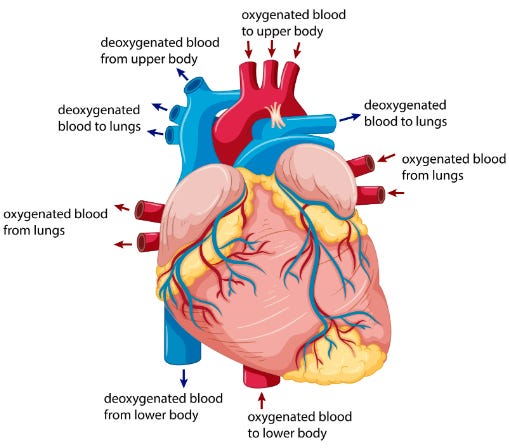The Circulation of Blood
Written by Lahari Chebrolu
Your circulatory system plays a crucial role in the flow of oxygenated and deoxygenated blood, from the heart to the rest of your body. This blood, once away from the heart, is used to deliver oxygen and remove carbon dioxide or waste, from areas such as small tissues to large organs.
Blood flow, overall, occurs in two parts, pulmonary circulation and systemic circulation. Pulmonary circulation is the flow of deoxygenated blood, from the heart to the lungs, for the purpose of bringing back oxygenated blood. Systemic circulation is when oxygenated blood in the heart is transported to all parts of your body.
Both pulmonary and systemic circulation occur through the four chambers; the right atrium, right ventricle, left atrium, and left ventricle. The right atrium and right ventricle are connected by the tricuspid valve, while the left atrium and left ventricle are connected by the mitral or bicuspid valve. First off, deoxygenated blood flows into the right atrium, from the superior and inferior vena cava, where it moves to the right ventricle, and the lungs, with the help of the pulmonary valve and arteries. Once the deoxygenated blood is oxygenated, in the lungs, it returns to the left atrium. From the left atrium, the blood moves to the left ventricle, and the rest of your body, through the aortic valve and aorta.
Conditions that could affect blood flow include heart valve disease, congestive heart failure, and peripheral artery disease. Other conditions include atherosclerosis, the build-up of plaque in the arteries, and aneurysms, which is caused by weak spots in the walls of your artery.
To improve overall circulation of blood, a healthy weight and diet should be maintained. Limiting the intake of alcohol, managing stress, and exercising daily are also beneficial habits.
References
https://my.clevelandclinic.org/health/articles/17060-how-does-the-blood-flow-through-your-heart
https://www.visiblebody.com/learn/circulatory/circulatory-pulmonary-systemic-circulation
Written by Lahari Chebrolu from MEDILOQUY


